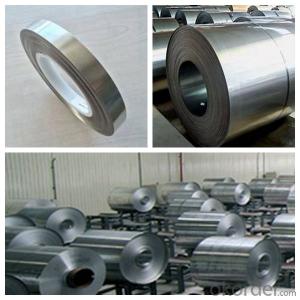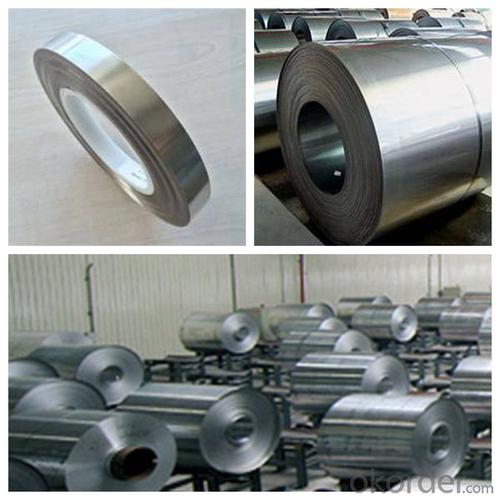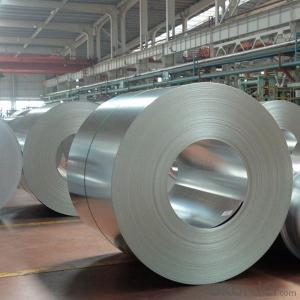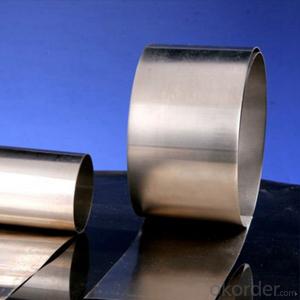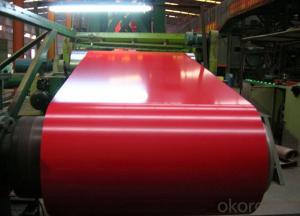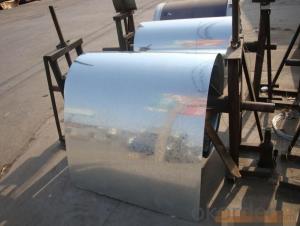Stainless Steel Made In China Good Quality 304 Stainless Steel
- Loading Port:
- Tianjin
- Payment Terms:
- TT OR LC
- Min Order Qty:
- 25 m.t.
- Supply Capability:
- 10000 m.t./month
OKorder Service Pledge
OKorder Financial Service
You Might Also Like
Specification
Description for Stainless Steel Coils/Sheets:
Prodcut:Stainless Steel Coil
Thinckness: 0.20mm-8.0mm
Width:1000mm, 1219mm(4 feet), 1250mm, 1500mm, 1524mm(5 feet),
1800mm, 2000mm, 2200mm, 2500mm,and customizable
Ni:0.8~1.2% Cu:1.4~1.5% Cr:14
Standard: ASTM, JIS, GB, BS, DIN etc
Grade: 200series&300series&400series
Surface finish: 2B, BA, 8K, 6K, Mirror Finished, No1, No2, No4, Hair Line with PVC
Manufacture technology: cold rolled/hot rolled
Thickness Tolerance: +/-0.1mm
Width Tolerance: +/-10mm
200 Seriers: 201,202
300 Seriers: 301, 304, 304L, 316L, 309, 310S,321
400 Seriers: 410, 410S, 409L,430
Specifications for Stainless Steel Coils/Sheets:
ITEM | DESCRIPTION |
Commodity | Stainless Steel Coil |
Material | 201, 202, 301, 321, 304, 304L, 316, 316L, 309S, 310S, 410, 430, etc. |
Surface | 2B, BA, 8K, No. 4 No.1 |
Standard | AISI, ASTM, DIN, EN, GB, JIS, etc. |
Specification | 1. Thickness : 0.3mm -120mm |
Application | 1. Automotive: Automotive trim and molding/Difficult-to-form exhaust-system |
Process | Hot rolled / cold rolled |
Payment | L/C,T/T |
MOQ | 20 Ton |
Productivity | 700 tons per month. |
Package | Standard seaworthy export packing or according to the customers' request. |
Delivery Time | It is based on the order, normally within 30 days after receiving your advance payment. |
Note | We can produce other standard as the customers' requirement. |
Detail picture for Stainless Steel Coils/Sheets
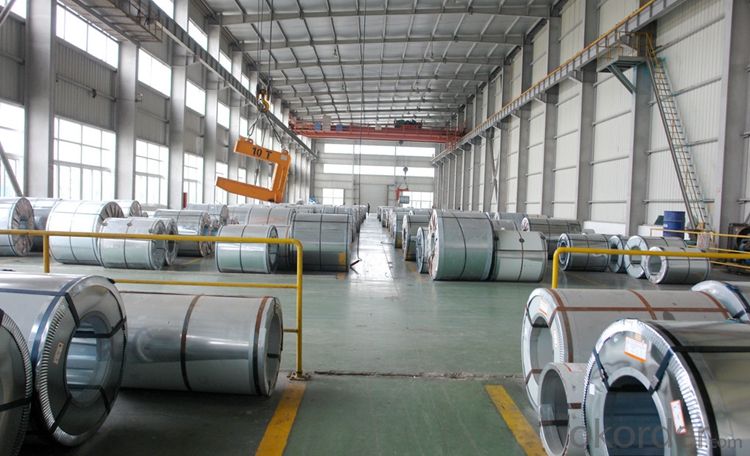
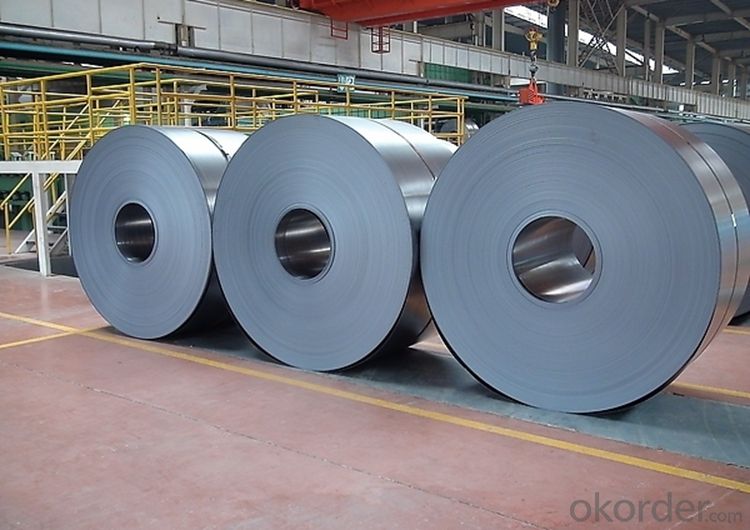

Application of Stainless Steel Coils
(1)Boiler heat exchanger,
(2)Chemical industries,
(3)Hardware fields,
(4)Construction material,
(5)Kitchen utensils,
(6)Building construction,
(7)Medical equipment,
(8)Chemical tank,
(9)Pipe etc
Export Markets for Stainless Steel Coils/Sheets:
Our target market is the international market. Every year we export most of products to countries like India, Pakistan, South Korea, Brazil, Australia, South Africa, Spain, Sri Lanka, Taiwan, Hong Kong, etc.
FAQ for Stainless Steel Coils/Sheets:
Q: How long is the delivery time?
A: Normally 30-40 days, but mostly according to the specific requirements or the quantity
Q: Could you send me sample?
A: We can supply you with the sample for free, but the delivery charges will be covered by customers.
FAQ for Stainless Steel Coils/Sheets:
Q: How can I get the samples?
A: If you need some samples to test ,please pay for the transportation freight of samples and our samples are free for you.
Q: How can I get your price list?
A: Please send us your email or fax and order information – Quantity, Specification (steel type, thickness, width, surface finish), then I can send you the price list.
- Q: How are steel coils inspected for uniformity using statistical analysis?
- Steel coils can be inspected for uniformity using statistical analysis through various techniques and procedures. The primary objective is to ensure that the steel coils meet the required specifications and have consistent quality throughout the entire coil. One common method of inspection is to collect a representative sample of steel coils from a batch or production run. These coils are randomly selected to ensure a fair representation of the entire batch. Statistical analysis is then performed on this sample to determine the uniformity of the coils. The first step is to measure various physical properties of the coils, such as thickness, width, weight, and surface defects. These measurements are recorded for each coil in the sample. The collected data is then analyzed using statistical techniques, such as mean, standard deviation, and range calculations. By calculating the mean values of the measured properties, it is possible to determine the average values for thickness, width, weight, etc. These mean values can be compared to the desired specifications to identify any deviations or inconsistencies. The standard deviation provides a measure of the variability or dispersion of the data, indicating how closely the coils conform to the desired specifications. A smaller standard deviation indicates greater uniformity. Additionally, range calculations can be performed to determine the difference between the maximum and minimum values of the measured properties within the sample. A smaller range suggests a higher level of uniformity. Statistical analysis can also involve the use of control charts, such as X-bar and R-charts, to visually monitor the variation in the measured properties over time. These charts provide a graphical representation of the data, allowing for the identification of any trends or out-of-control conditions. Overall, statistical analysis allows for a systematic evaluation of the uniformity of steel coils by providing objective measurements and statistical indicators. By analyzing the collected data, manufacturers can identify any deviations from the desired specifications and take appropriate corrective actions to ensure consistent quality throughout the production process.
- Q: How do steel coils compare to other materials, such as aluminum or copper?
- Steel coils have several advantages over other materials such as aluminum or copper. Steel is stronger and more durable, making it an excellent choice for applications that require high tensile strength and resistance to wear and tear. Additionally, steel coils have a higher melting point than aluminum, making them more suitable for high-temperature environments. Copper, while a good conductor of electricity, is generally more expensive than steel and may not offer the same level of strength and versatility. Overall, steel coils are a cost-effective and reliable option for various industrial and construction purposes.
- Q: Well the other day i told my friend that when you put a compass near steel it will screw up and he said only magnets do that then i showed him and it worked then he said: that'ss because steel has its own magnet in it coz it builds up static electricity is that correct what he said? thanks
- No. Steel does not build up static electricity by itself. Also, magnetic fields are made by moving electricity, not static electicity. The steel conducts magnetism, so it changes the earth's magnetic field near itself by conducting the field through itself. The larger effect is a magnet near a piece of steel: the compass has a magnet, and when you place it near a ferromagnetic material, it attracts. Try putting a refridgerator magnet against the fridge - it sticks because it attracts.
- Q: What are the dimensions and weight range of steel coils?
- Steel coils can come in various dimensions and weight ranges depending on the intended use and industry requirements. The dimensions of steel coils typically range from 0.15mm to 3.5mm in thickness, and from 600mm to 2,000mm in width. The weight range of steel coils can vary widely, but commonly falls between 5 and 25 metric tons. The specific dimensions and weight range of steel coils are determined by factors such as the type of steel, the production method, and the desired application.
- Q: Does anyone know how to make a steel helmet, or does anyone know where to direct me websites-wise? i've just started looking on the web for info, so when i get back here i might've already found some info, but more wouldn't hurt, especially if from people who are interested on the subject. i know nothing about metallurgy, nothing on the art of metal working etc... please help.
- The okorder (Artist Blacksmiths) or on the sites of the two organizations that reproduce old costumes and tools - one is called The Society for Creative Anachronism, not sure of the other. Search terms to use might be hammering a helmet and forging medieval armor
- Q: What is the process of galvanizing steel coils?
- Enhancing the durability and protecting steel coils from corrosion involves a series of steps in the galvanization process. To begin, the steel coils undergo a thorough cleaning to eliminate any dirt, oil, or impurities on the surface. This is achieved through an acid pickling process, where the coils are immersed in a diluted acid solution or treated with a chemical cleaner. The aim is to ensure the surface of the coils is free from contaminants, allowing for better adhesion of the zinc coating. Following the cleaning process, the coils are rinsed to remove any remaining acid or cleaner, preventing adverse reactions in the next stage. The subsequent step involves the actual galvanization, where the cleaned coils are submerged in a bath of molten zinc. To guarantee an even coating, the coils are carefully passed through the zinc bath using rollers or other mechanisms. The zinc bath is maintained at a specific temperature, typically around 450°C (842°F), enabling the molten zinc to bond with the steel surface. Upon withdrawal from the zinc bath, excess zinc is eliminated by passing the coils through air knives or by centrifugal spinning. This ensures control over the thickness of the zinc coating, resulting in a uniform appearance. Once the galvanization process is complete, the steel coils are gradually cooled to room temperature. This facilitates the solidification and firm bonding of the zinc coating with the steel surface, creating a protective barrier against corrosion. The final step involves inspection and quality control. The galvanized steel coils are carefully examined for any defects, such as uneven coating or areas with insufficient zinc coverage. This inspection is typically conducted visually or using specialized equipment capable of detecting anomalies. Additionally, the coating thickness is measured to ensure it meets the required specifications. In conclusion, the galvanization process for steel coils is designed to enhance their longevity and shield them from rust and corrosion. By applying a layer of zinc coating to the steel surface, the coils become more resistant to environmental factors, making them suitable for a wide range of applications across various industries.
- Q: Can steel coils be coated with heat-resistant materials?
- Yes, steel coils can be coated with heat-resistant materials. Coating steel coils with heat-resistant materials provides protection against high temperatures and ensures the durability and longevity of the coils in various industrial applications.
- Q: in broken steel can you to missions and get things like the dog, you previously didnt do/get in fallout 3?
- I wish you people would put your questions in the right place.
- Q: What are the common coil storage conditions?
- Common coil storage conditions include keeping the coils in a dry and well-ventilated area, away from direct sunlight and moisture. It is also important to store the coils in a clean and organized manner, preferably on pallets or racks, to prevent damage or deformation. Additionally, maintaining a stable temperature and humidity level is crucial to minimize the risk of corrosion or other forms of deterioration.
- Q: So...I'm learning about how steel is made and I'm wondering if there is a more environmentally friendy method. I view it as unfriendly b/c of the oxygen that is injected when the steel is in the blast furnace or electric arc furnace. This oxygen bonds w/ the carbon to produce CO and CO2. THis is necessary to reduce the amount of carbon content to produce harder steels. So what other methods are there that can be used w/o having to end up w/ co and co2? thanks
- From what I understand of it, US steel is better as the steel is more recycled than Canadian, so a lot of that oxygen / CO2 has already taken place compared to working from ore. The second reason US steel is environmentally ahead of Canadian is that US tends to use Electric Arc, while Canadian uses Basic Oxygen, Basic Oxygen uses more energy than electric arc, and I think it also uses more oxygen, but I would suspect that oxygen that it uses is 'waste oxygen' and not converted into Co2 because the Co2 process is limited by the carbon, and steel only has so much carbon.
Send your message to us
Stainless Steel Made In China Good Quality 304 Stainless Steel
- Loading Port:
- Tianjin
- Payment Terms:
- TT OR LC
- Min Order Qty:
- 25 m.t.
- Supply Capability:
- 10000 m.t./month
OKorder Service Pledge
OKorder Financial Service
Similar products
Hot products
Hot Searches
Related keywords
